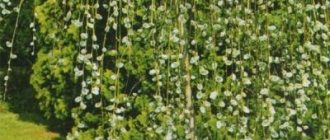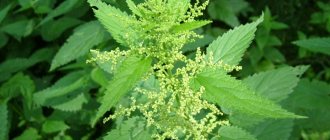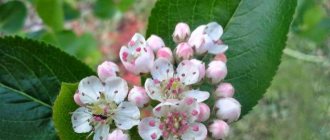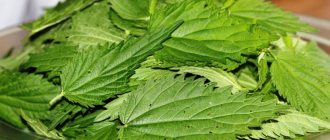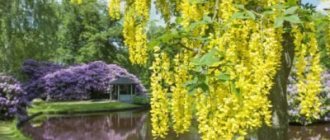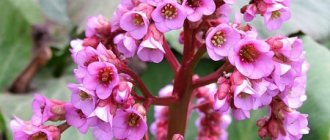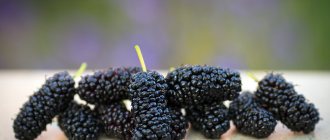Types and varieties
Only nine echinaceas are found in nature. Gardeners prefer to grow combined types.
Echinacea purpurea
This is a perennial flower that reaches a height of up to 1 m. The shoots are erect, and the leaves have a lacent configuration, their color is brownish, and quite wide, collected in a rosette.
The flowers are baskets, in the middle of which there are tubular flowers of a chestnut tone, and on the edge there are pinkish-violet flowers, reaching a span of 40 mm. The most popular types:
- Granatstern. The bush reaches a height of up to 1.3 m, and its baskets are 13 cm. The flowers are plum-colored and slightly pubescent.
- Sonnenlach. It reaches a height of up to 1.4 m. Its inflorescences are 10 cm in diameter, these include lanceolate flowers of a dark red color, the length of which is 35 mm, and at the top they have 2-3 teeth.
Echinacea Sunset
It is a hybrid plant, developed by crossing purple and paradoxical echinacea. These species have excellent qualities that have been combined.
They have fairly large inflorescences, a pleasant aroma, beautiful shades, and curved leaves. There are subspecies with unusual colors: silver, plum, orange, golden.
Previously, we talked about another amazing flower for your garden - Erantis.
The most common varieties:
- Julia. The plant is compact, as its height is only 0.45 m. At the beginning of summer, orange-colored baskets bloom. Flowering is quite long.
- Cleopatra. The diameter of the flowers is 75 mm, the color of the inflorescences is golden, the reed buds are arranged horizontally.
- Evening Glow. The inflorescences are golden in color with a horizontal stripe of orange, and in the middle there are tubular flowers protruding beyond a dark-colored cone.
- Cantaloupe. The baskets are melon-colored. The petals of the tongue are arranged in two rows and resemble a toad. And the shaggy hemisphere includes buds of a darkish color.
- Action flut. It is an unusual species because the buds are yellow and rolled into a tube. They are drought tolerant and very easy to care for.
- Double Scoop Cranberry. This species is easy to care for. Baskets can be of various colors. Florists use them to create flower arrangements.
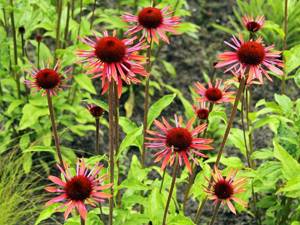
New species of Echinacea
Variety "Julia" - this type of plant decorates gardeners' garden plots with its orange flowers. People have already given him a new nickname - “Butterfly Kisses.” A dwarf variety of echinacea will perfectly decorate a small space. It grows no more than 40-45 centimeters in height.
Popular: Care and feeding of the predatory Dionaea at home
The variety prefers to grow in open, sunny areas; it can tolerate hot summers quite well. Abundant flowering occurs quite early; already at the beginning of the summer season its large heads adorn the flower beds. The decorative flower can be added to various bouquet arrangements.
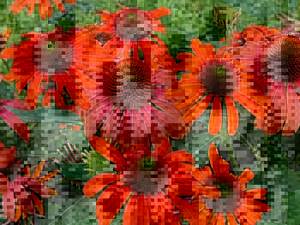
Double Scoop Cranb variety
The plant is particularly attractive when it blooms. No one can pass by him indifferently, how beautiful he is. Passers-by are struck by the bright color of echinacea, similar to bloody rowan. Looks appropriate in joint plantings with Russian sage.
In addition to other extraordinary advantages, the plant boasts other positive qualities, for example:
- the flower is quite tolerant of dry weather;
- Echinacea of the Double Scoop Cranb variety is unpretentious in care;
- Its beautiful appearance attracts beneficial insects.
You can admire the flowering of this plant all summer long.
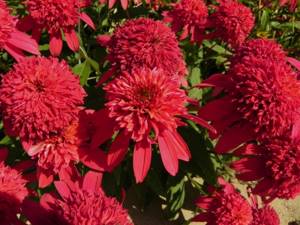
Variety "Flute of Passion"
Over the past ten years, Echinacea has evolved significantly. This variety is distinguished by its curled petals. Outwardly, they resemble a musical trumpet - a flute, but from the outside this sight is unusual. The developed variety was crossed with the equally famous pink coneflower, All That Jazz.
The new variety takes on the curled nature of the petals, but it differs in color - the inflorescences are golden yellow. The plant is quite tall, in some cases the height of the flower is 1-1.2 meters. Flowering does not last long, only 2-3 months.
The variety is distinguished by its endurance in dry weather, like many echinaceas, and does not show capriciousness in care. In winter, unharvested flower heads provide food for forest birds.
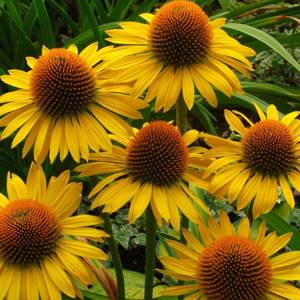
Beneficial features
The grass of this plant contains many useful microelements:
- polysaccharide;
- saponin;
- resin;
- oils;
- acid and many others.
Echinacea preparations have antimicrobial, antifungal, and antiviral effects. Also, such remedies strengthen the immune system and relieve stress.
The tincture of this plant helps to increase potency and prompt healing of burns. Juice squeezed from vigorous plants is used in non-standard medicine to heal wounds, and when used from the inside, blood clotting is accelerated.
Echinacea purpurea is known in a large number of countries. In Germany, remedies from this flower are used in the treatment of angina pectoris and chronosepsis. Some scientists claim this species has the same healing properties as ginseng.

Recipes
Here are echinacea recipes you can make at home if needed:
- Dyeing. Take a 500ml glass jar and fill it with fresh cut echinacea flowers. Then fill them with alcohol and close the container with a twist lid. Remove the container to an unlit place for forty days. Then the tincture is poured into another container. Helps with stress, depression, infections.
- Root decoction. 300 mg of water should be mixed with 1 large spoon of crushed echinacea roots. The mixture is placed in a water bath and boiled for 30 minutes. After the broth has cooled, it must be drained. Drink 3 or 4 times a day, 1-2 large spoons. Helps with colds, fatigue and the most dangerous infectious diseases.
Contraindications
Echinacea products sometimes cause an allergic reaction. They should not be used by pregnant women, or while breastfeeding, or by people with multiple sclerosis, progressive tuberculosis, leukemia, or collagenosis. And they cannot be used by people with individual intolerance. In general, before using such drugs, it is recommended to consult a specialist.
Growing
What time to plant
In spring and autumn, planting is carried out in open ground. It is possible to grow using seeds and the vegetative method.
The place for planting should be: sufficiently illuminated, and the soil should contain a small amount of alkali, and if the soil is sour, this is corrected with lime. But moist soil is not suitable for this plant.

Landing Features
- When the seedlings are planted, the depth of the holes is about 50 mm and the distance is 30 cm.
- The pre-dug hole should be deeper than the root system of the plant itself.
- Echinacea should be planted after fertilizing the soil with compost. After planting, it is necessary to irrigate the flower abundantly.
- Growing in containers is possible, but after the shoots appear, you need to transplant the echinacea into a hole along with a lump of soil.
Echinacea propagation
Most often, reproduction is carried out by vegetative division of the bush. As a rule, it is carried out in spring or autumn.
Only after the bush is 4 years old can 1 division be carried out. It is necessary to carefully dig out the plant, but do not touch the rhizome, and then the bush is divided into a couple of segments.
Propagation by seeds is most common among gardeners.
Preferred temperature is 13 degrees for sowing seeds in spring. The sown seeds are not buried, but are sprinkled with a layer of earth. But this method is bad because young seedlings do not tolerate climate change.
Containers can be used for this purpose.
The seeds are buried 5 mm into the substrate; seedlings will not appear soon, since they grow only after 6 weeks. Then such seedlings are planted in the ground. Flowering occurs only in the 2nd year.

Echinacea after flowering
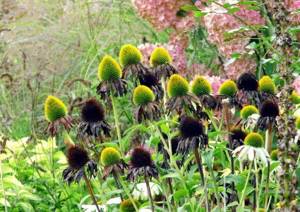
In winter, shelter is required only in regions where there are long and cold winters with large amounts of precipitation (Siberia, the Urals, Karelia and the Murmansk region). In the southern regions of Russia, preparations for wintering are not carried out. In the fall, after flowering has ended, you need to trim the bush, and then mulch the soil well with humus or a layer of sawdust up to 7 cm thick. After this, cover the echinacea with spruce branches, but it is better to use agrofibre or straw.
Echinacea seeds are collected in stages, as they ripen gradually. The maturity of the achene can be determined by the presence of a dark part in the center. After this, it can be carefully removed from the faded bud and dried. They quickly lose their germination capacity, so you need to sow planting material as soon as possible.
Diseases and pests
The plant is very resistant to diseases. But it is still possible to get sick while eating, and this happens most often due to improper care.
Powdery mildew appears when there is excessive temperature fluctuations.
It is possible to overfeed with nitrogen, then white spots appear on the plant and it must be sprayed with a mixture of burgundy or colloidal silver color.
In addition, this species suffers from sercospora or septoria, which are also fungal diseases.
Spots appear on the leaves and over time the leaves die and fall off.
At the first stage, you need to cut off the diseased leaves, and if the disease progresses, the echinacea should be sprayed with a fungicidal substance.
With viral diseases, flower stalks lose their shape and leaves turn yellow.
At the initial stage of infection, painful bushes should be dug up and destroyed, and the area should be disinfected with a very strong solution of potassium manganese.
Bugs and slugs may appear on the bushes. In order to kill insects, insecticides are used in medicines (actellik).

Echinacea in the garden
The flower will decorate the backyard mixborders, where they are planted in the form of a semicircle in separate groups. In a mixed flower garden you can find plantings of various varieties of Echinacea. Flowers also feel great next to tall plantings: trees, shrubs.
When forming mixborders, it is recommended to plant low-growing varieties of echinacea in the first line. They can be combined with other low perennial plantings in the form of herbaceous plants. They will also look great in gardens in a natural environment.
In the front garden, Echinacea appears as bright colorful spots, attracting forest birds, beneficial insects and butterflies to the area. In addition, Echinacea is considered an excellent honey plant, so bees are also guests here in the garden. If you leave the plants to ripen to seed, they will become a bird feeder in winter. In flower beds, echinacea can most often be seen next to tall dahlias, gorgeous rudbeckia, and blood-red salvias (about it). Plantings with ornamental and herbaceous plants look nice.
Growing echinacea in the garden is an easy task that only brings pleasure from contemplating its beauty. Echinacea is not particularly capricious in its care; it needs to be watered, loosened and fertilized as needed. For many years, the site can be decorated with flowers of coral, pink, burgundy, and white. These plants will be a highlight for any mixborder. It’s simply impossible not to fall in love with such flowers.
Currently reading:
- Flowering of capricious oncidium, after careful transplantation
- Planting to decorate the site with three types of coniferous trees
- Tips for keeping poinsettias at home
- Exquisite juncus (rumen) spiral-shaped in the interior
Share the news on social networks
About the author: Lyudmila Vasilievna Nosikova
Agronomist of the state agricultural enterprise "Garovskoe" of the Khabarovsk region of the Khabarovsk Territory.

